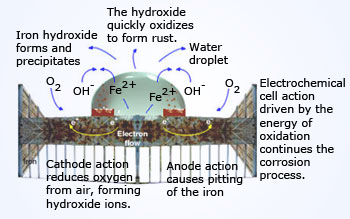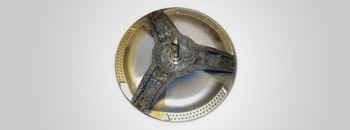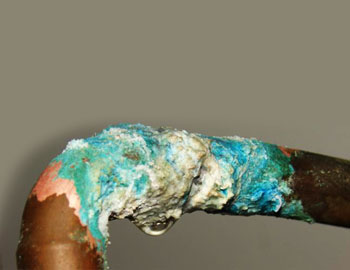 Mechanism of rusting
The formation of rust can occur at some distance away
from the actual pitting or erosion of iron. This is possible because the electrons produced
via the initial oxidation of iron can be conducted through the metal and the iron ions can
diffuse through the water layer to another point on the metal surface where oxygen is
available. This process results in an electrochemical cell in which iron serves as the
anode, oxygen gas as the cathode and the aqueous solution of ions serves as a "salt
bridge".
Mechanism of rusting
The formation of rust can occur at some distance away
from the actual pitting or erosion of iron. This is possible because the electrons produced
via the initial oxidation of iron can be conducted through the metal and the iron ions can
diffuse through the water layer to another point on the metal surface where oxygen is
available. This process results in an electrochemical cell in which iron serves as the
anode, oxygen gas as the cathode and the aqueous solution of ions serves as a "salt
bridge".
Corrosion occurs in the presence of moisture. For example when iron is exposed to moist air, it reacts with oxygen to form rust, Fe2O3. XH2O.
The amount of water complexed with the iron (III) oxide (ferric oxide) varies as indicated by the letter "X". The amount of water present also determines the colour of rust, which may vary from black to yellow to orange−brown. The formation of rust is a very complex process, which begins with the oxidation of iron to ferrous (iron +2) ions.
Fe  Fe+2 + 2e–
Fe+2 + 2e–
Both water and oxygen are required for the next sequence of reactions. The iron (Fe+2) ions are further oxidized to form ferric ions (Fe+3) ions.
Fe+2 Fe+3 + 1e–
Fe+3 + 1e–
The electrons provided from both oxidation steps are used to reduce oxygen as shown:
O2(g) + 2H2O + 4e– 4OH–
4OH–
The ferrous ions then combine with oxygen to form ferric oxide [iron (III) oxide], which is then hydrated with varying amounts of water. The overall equation for the rust formation may be written as:



